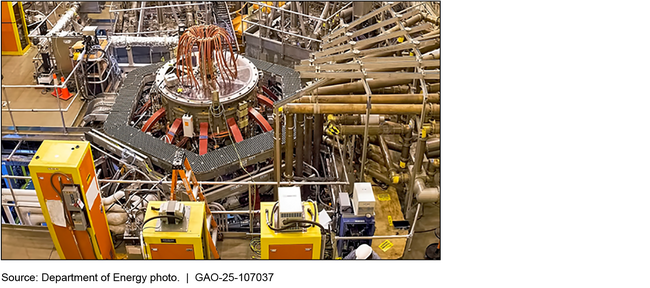Fusion Energy: Additional Planning Would Strengthen DOE's Efforts to Facilitate Commercialization
Fast Facts
Fusion—the process that powers the sun—could produce commercial electricity to help meet growing clean energy needs. But there are technical, economic, and other challenges.
The Department of Energy's Fusion Energy Sciences program has started investing in public-private partnership initiatives and taken steps to develop a fusion energy strategy. For example, it has partnered with industry and universities on research and development to design fusion power plants.
But Energy hasn't developed metrics or timelines to guide its efforts. Doing so is vital to scaling up fusion energy technologies for commercial use.
Our recommendation addresses this.

Highlights
What GAO Found
The Department of Energy (DOE), led by the Office of Science's Fusion Energy Sciences (FES) program, has taken steps to facilitate fusion energy commercialization through public-private partnerships. These efforts represented about 1.2 percent (about $36 million) of FES's total funding obligations on average during fiscal years 2020 through 2023. The rest of FES's funding obligations (about 98.8 percent on average, or about $740.8 million) went to efforts to study, among other things, the science of plasma, collaborate internationally, and maintain facilities. DOE officials indicated that the relatively limited scale of investment in initiatives to facilitate commercialization largely reflects the immature state of fusion energy technology, which GAO reported on in March 2023. Another DOE entity—Advanced Research Projects Agency-Energy (ARPA-E)—obligated nearly $50 million in fiscal year 2020, and about $8.7 million on average during fiscal years 2021 through 2023 to fusion energy commercialization projects.
A Fusion Device at the Department of Energy's Princeton Plasma Physics Laboratory

DOE has taken some steps to develop a vision and strategy for commercial fusion energy. For example, DOE joined an interagency working group aimed at accelerating fusion energy, among other innovations. FES created a division in April 2024 to manage strategic partnerships with private and public entities and support the transition to fusion energy demonstration and deployment activities. FES also released reports on its vision and strategy in June 2024 that identified risks to fusion energy commercialization. Although DOE has initiated planning efforts to facilitate fusion energy commercialization, whether DOE sustains these efforts is uncertain. DOE officials told GAO the interagency working group has been inactive. Working group organizers told GAO that fusion technology is in the early stages and deferred to DOE on how to facilitate commercialization. Further, DOE does not indicate with specificity or with timelines how it plans to respond to the risks identified in its June 2024 strategy. DOE's pending planning effort is expected to outline metrics and timelines. Finalizing and implementing ongoing planning efforts would better position DOE to make progress toward accelerating fusion energy commercialization and meeting the U.S. goal of net-zero greenhouse gas emissions by 2050.
Why GAO Did This Study
Fusion, the process that powers the sun, could produce commercial electric power to help meet growing clean energy needs if technical, economic, and other challenges are overcome. Fusion is also one of five prioritized areas to meet the U.S. goal of net-zero greenhouse gas emissions by 2050.
Congress appropriated about $760 million for FES in fiscal year 2023 to support fusion activities, including public-private partnerships.
GAO was asked to examine DOE's steps to reach the federal vision to accelerate fusion energy commercialization. This report examines (1) the status of DOE's initiatives to facilitate fusion energy commercialization, and (2) the extent to which DOE has planned for facilitating such commercialization.
GAO reviewed DOE documents; analyzed budgetary data; and interviewed federal officials and a nongeneralizable sample of eight stakeholders representing universities, industry, and interest groups. GAO selected these stakeholders based on their participation in or publication about DOE's fusion energy initiatives, and to provide a range of perspectives.
Recommendations
GAO recommends that the Office of Science finalize and implement ongoing fusion energy planning efforts, including by specifying roles and responsibilities, responding to identified risks, and detailing metrics and timelines for its initiatives.
Recommendations for Executive Action
| Agency Affected | Recommendation | Status |
|---|---|---|
| Office of Science | The Director of the Office of Science should finalize and implement ongoing fusion energy planning efforts, including by specifying roles and responsibilities, responding to identified risks, and detailing metrics and timelines for its initiatives. (Recommendation 1) |
When we confirm what actions the agency has taken in response to this recommendation, we will provide updated information.
|
